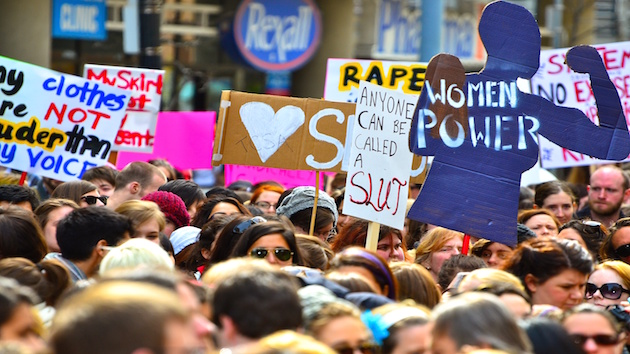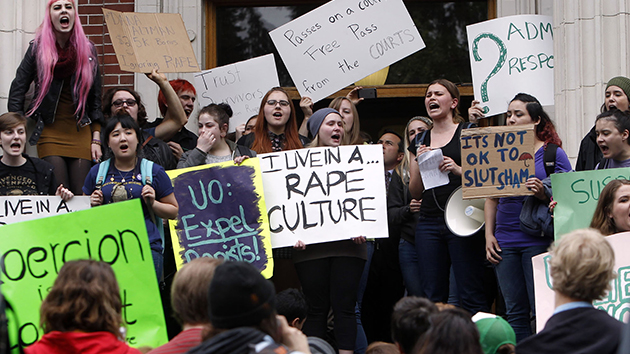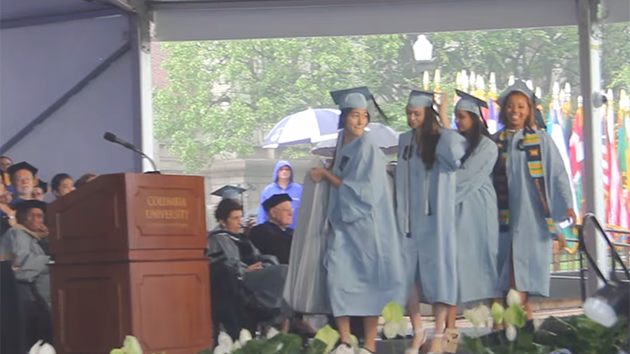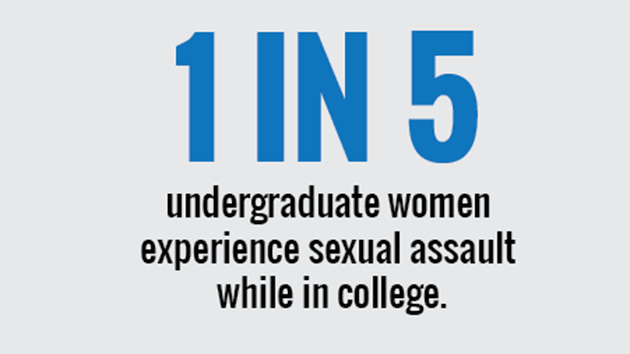
<a href="https://upload.wikimedia.org/wikipedia/commons/thumb/9/9a/Toronto-Slutwalk.jpg/800px-Toronto-Slutwalk.jpg">Anton Bielousov</a>/Wikipedia
The Association of American Universities released findings Monday from one of the largest-ever surveys on college sexual violence—comprising more than 150,000 students across 27 colleges—and they paint a bleak picture of sexual assault on college campuses.
The survey asked students whether they had experienced events ranging from sexual touching to forcible penetration. If they answered affirmatively, they were asked follow-up questions about the circumstances and the event’s aftermath, including whether they reported the incident to law enforcement or a campus authority. Some scenarios that appeared in the survey fit the legal definitions for rape and sexual battery, while others involved incidents that universities typically consider to be sexual misconduct. Other questions measured attitudes toward campus sexual assault and how often students intervened when they observed potentially risky situations.
Here are a few takeaways:
- More than 1 in 5 undergraduate women are victims of sexual assault. The AAU’s findings suggest sexual-assault rates are slightly higher than the widely cited yet disputed statistic that 1 in 5 college women are victims of sexual assault. According to the survey, 23 percent of female respondents said they experienced nonconsensual sexual contact due to physical force, under the threat of physical force, or while they were incapacitated by drugs or alcohol. Among seniors nearing graduation, that number rises to 1 in 3.
- In the last academic year alone, 11 percent of respondents said they experienced nonconsensual sexual contact. That’s around 16,500 students across the 27 institutions.
- First-year students are are the most vulnerable to sexual assault. Sixteen percent of freshman women said they experienced sexual contact under physical force or incapacitation.
- The vast majority of students don’t report sexual assault or misconduct. While most victims said they confided in a friend, family member or someone else, only 26 percent of students who experienced forcible penetration filed an official report. More than half of those victims said they didn’t consider the event serious enough to go to the authorities, while one-third of said they were “embarrassed, ashamed, or that it would be too emotionally difficult.” Others said they “did not think anything would be done about it.” Students were much more likely to report certain kinds of events than others, with reports filed by 28 percent of stalking victims but only 5 percent of those who experienced unwanted sexual touching while they were incapacitated by drugs or alcohol.?
- Transgender and gender-nonconforming students experience sexual assault and misconduct at higher rates than their peers. These students comprised 1.5 percent of survey respondents, but nearly 40 percent of seniors identifying with this group said they had experienced nonconsensual sexual contact in college, compared to a third of senior women. They’re also less likely to believe the university will conduct a fair investigation or take their reports seriously.
- Response rates were low. About 19 percent of students across the 27 universities chose to respond to the online survey, which was conducted during a three-week period in April. The survey notes that nonvictims may be less likely to participate, skewing incidence rates slightly upward. Still, final participation rates were well below the the rates of similar studies.
At least 12 of the colleges that released results on Monday are currently facing federal scrutiny from the Department of Education’s Office of Civil Rights for their handling of sexual-assault cases under federal Title IX standards. Several universities on the list have been found in violation of Title IX, including the University of Virginia, Harvard University, Yale University, and Michigan State University.
Given a range of responses across institutions, the study’s authors caution against generalizing the results on a national scale. As Slate points out, the researchers declined to explain the variation in sexual-assault rates or students’ attitudes at different institutions. “The analyses did not find a clear explanation for why there is such wide variation,” the authors write. “Some university characteristics, such as size, were correlated with certain outcomes. But the correlation is not particularly strong.”
This post has been updated.












